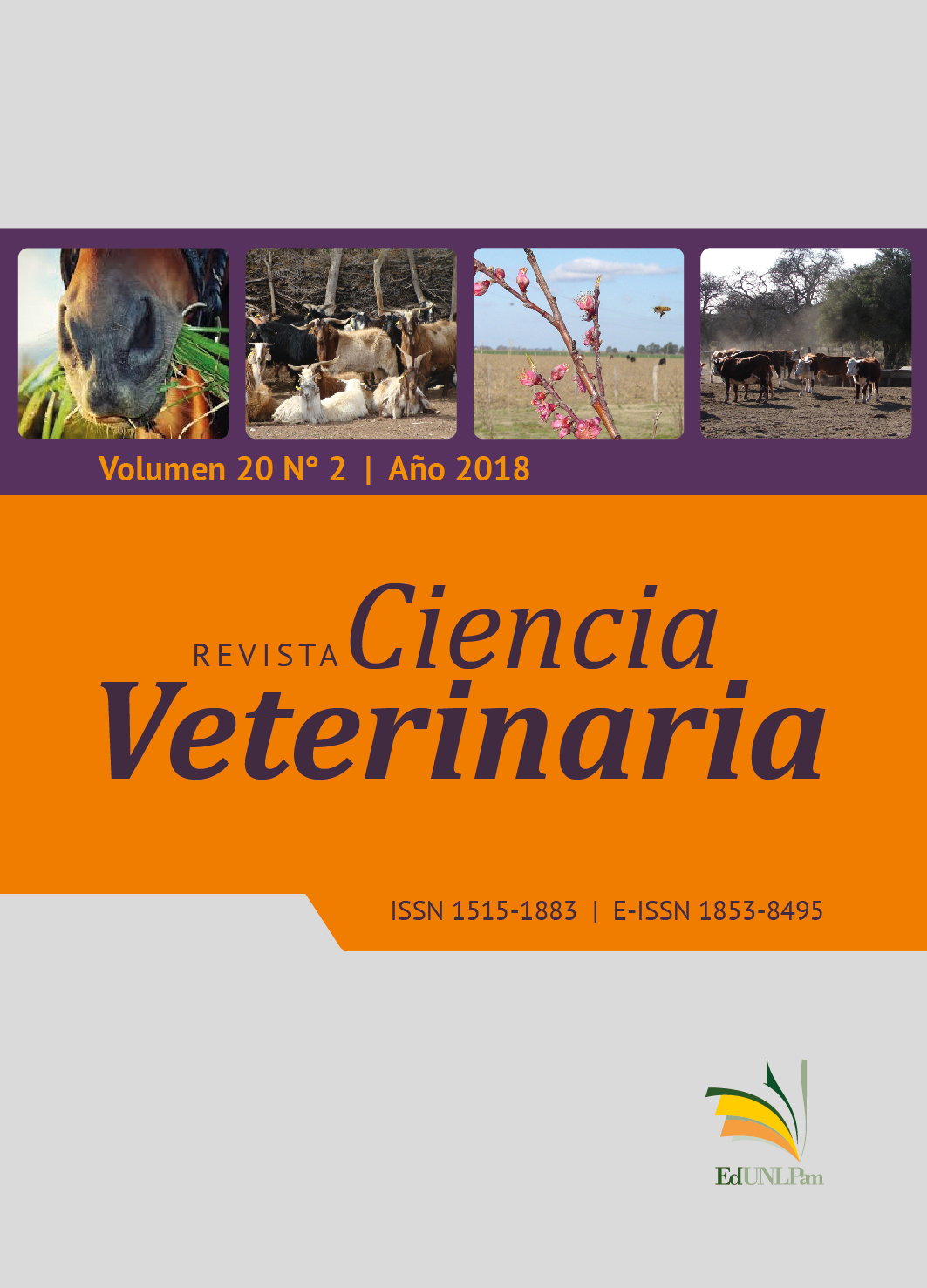Relationship between particle size in equine feces and nutritional quality of forage consumed
DOI:
https://doi.org/10.19137/cienvet-201820205Keywords:
equines, nutrition, growth, digestibilityAbstract
In horses production and health, nutrition is critical; equines are non-ruminant herbivores and knowing the quality of forages that graze, is essential for nutritional assessment. Thus, we set out to evaluate the proportion of particle sizes of fresh feces of horses that graze different types of forages. We used the commercial instrument Nasco Digestion Analyzer
to wash the samples of fresh feces and pass them through a structure of 3 stainless steel sieves with decreasing pore diameter, being: A:> 4.8 mm; B: 4.8-3.2 mm; C: 3.2-1.6 mm and D: <1.6 mm, the remnant that escapes. 31 samples of fresh feces were obtained from adult Race Purebred Horse mares. The treatments were: 1. Diet Pp (n: 9) consociated pasture; 2. Diet Ss (n: 8) soy summer greengrass; 3. Diet Mn (n: 7) corn summer greengrass and 4.Diet Aa (n: 7) oatmeal summer greengrass. The forage samples
were analyzed for dry matter (MSF), in vitro digestibility (DIG), fiber in neutral detergent (NDF) and fiber in acid detergent (ADF). Our results show that the proportions accumulated by particle size of fresh stool material are different according to the type of diet (p: <0.05), for particle size greater than 4.8 mm (sieve A), being the values for each diet: Pp: 47%, Ss: 27%, Mn: 13% and Aa: 2%. We also found relationships between parameters of nutritional quality of grazed forages and particle sizes in fresh feces with significant statistical levels (p <0.05), namely: DIG: A, r: -0.51 (p: 0) , 0037); DIG: D, r: 0.57 (p: 0.0008); FDN: A, r: 0.51 (p: 0.0034); FDN: D, r: -0.56 (p: 0.0011); FDA: A, r: 0.59 (p: 0.0005); FDA: A, r: 0.63 (p: 0.0001). Possibly, more evaluations about the forage / feces interaction with this method are needed to be able to define a descriptive model in this regard
Downloads
References
Paz S; Pellegrini AG.. Construyendo el Sistema de Producción con Énfasis en la Nutrición Equina. Criollos. En: Anuario de Asociación Criadores de Caballos,2008,
:174-177.
NRC. 2007. Nutrient Requeriment of Horses. 6th Edition. Washington, D.C. U.S.
Gil-Jiménez, E; Villamuelas, M; Serrano, E; Delibes, M; Fernández, N; Fecal Nitrogen Concentration as a Nutritional Quality Indicator for European Rabbit Ecological Studie, Journal PLoS ONE, 2015, Vol 10 (4).
INRA. 2015. Equine nutrition, INRA nutrient requirements, recommended allowances and feed tables. Ed. Wageningen Academic Publishers. The Netherlannds, 696p.
Cymbaluk, NF. Comparison of forage digestion by cattle and horses, Journal Animal Science, 1990, 70: 601-610.
6. Cangiano, CA.1997. Producción Animal en Pastoreo. INTA. Ed. La Barrosa, Argentina, 145p.
Darlington JM; Hershberger TV. Effect of Forage Maturity on Digestibility, Intake and Nutritive Value of Alfalfa, Timothy and Orchardgrass by Equine. Journal Animal Science, 1968, 27: 1572-1576.
Sales J; Homolka P; Koukolová V. Prediction of Energy Digestibility of Hays in Horses. Journal of Equine Veterinary Science, 2013, xxx 1-7.
Hutjens MF. Finding Feeding Bottlenecks on Dairy Farms. En Four State Dairy Nutricion and Managment. Conference, Iowa 2016 Junio 15- 16. Universidad Estatal de Iowa, 2016, p. 92-97.
Henneke DR, Potter GD, Kreider JL and Yeates BF. Relationship Between Condition Score, Physical Measurements and Body Fat Percentage in Mares. Equine Veterinary Journal,1983, 15 (4):371 – 372.
Van Weyenberg S, Sales J and Janssens GPJ.. Passage rate of digesta through the equine gastrointestinal tract: A review. Livestock Science 2006, 99: 3-12.
Goering HK and Van Soest PJ.. Forage fiber analyses, Apparatus, Reagents, Procedures, and Some Applications. Agriculture Handbook No. 379. Agricultural Research Service,1970, Washington, D.C. 24p.
Van Soest PJ and Robertson JB. 1980. Systems of analysis for evaluating fibrous feeds. En: Standardization of Analytical Methodology in Feeds. Pigden, W J; Balch, C C; Graham, M, International Research Development Center, Ottawa, Canada.pp. 49–60.
Di Rienzo JA; Casanoves F; Balzarini MG; Gonzalez L; Tablada M; Robledo CW. InfoStat versión 2011. Grupo InfoStat, FCA, Universidad Nacional de Córdoba, Argentina.
SAS. 2018. Institute Inc. SAS ® 9.4. Cary, NC: SAS Institute Inc., USA.
Uden P; Van Soest PJ.. The determination of digesta particle size in some herbivores. Animal Feed Science and Technology, 1982, 7: 35-44.
Grenet E; Martin-Rosset W; Chenost M.. Compared size and structure of plant particles in the horse and the sheep feces. Journal Animal Science, 1984, 64:345-346
Zwirglmaier, S; Remler HP; Senckenberg E; Fritz J; Stelzer P; E. Kienzle.. Effect of dental correction on voluntary hay intake, apparent digestibility of feed and faecal particle size in horse. Journal of Animal Physiology and Animal Nutrition, 2011, 1-8.
Carmalt JL; Allen AL.. Effect of rostrocaudal mobility of the mandible on feed digestibility and fecal particle size in horses. Journal of the American Veterinary Medical Association, 2006, 229: 1275–1278.
Carmalt JL; Cymbaluk NF; Townsend HGG.. Effect of premolar and molar occlusal angle on feed digestibility, water balance, and fecal particle size in horses. Journal of the American Veterinary Medical Association 2005, 227:110–113.
Bastianelli D; Bonnal L; Jaguelin-Peyraud Y; Noblet J.. Predicting feed digestibility from NIRS analysis of pig faeces. Journal Animal, 2015, 9(5): 781–786.
Tolleson DR; Schafer DW.. Application of fecal near-infrared spectroscopy and nutritional balance software to monitor diet quality and body condition in beef cows grazing Arizona rangeland. Journal Animal Science, 2014, 92: 349–358.
Kidane NF; Stuth JW; Tolleson DR.. Predicting Diet Quality of Donkeys via Fecal-NIRS Calibrations. Rangeland Ecology & Management ,2008, 61 (2): 232-239.
Mésochina, P; Martin–Rosset W; Peyraud JL: Duncan D; Micol D; Boulot S.. Prediction of the digestibility of the diet of horses: evaluation of faecal índices. Grass and Forage Science, 1998, 53: 189-196.
Glunk EC; Pratt-Phillips SE; Siciliano PD. Effect of Restricted Pasture Access on Pasture Dry Matter Intake Rate, and Fecal pH in Horses. Journal of Equine Veterinary Science, 2012, xxx:1-6.
Kohnke J. 1992. Feeding and Nutrition. Ed. Birubi Pacific, Australia. 197 p.
Pellegrini AG y Paz S. El valor nutritivo del forraje para el equino. La Especie Equina; 2016, 15(55): 44-48
Hoskin SO; Gee EK. Feeding value of pastures for horses. New Zealand Veterinary Journal, 2004, 52 (6): 332-341.
Topayan MV, Pellegrini AG y Paz S. Pruebas de Digestibilidad en Equinos. La Especie Equina.2017; 16(58): 36-40.
Downloads
Published
Issue
Section
License
Al momento de enviar sus contribuciones, los colaboradores deberán declarar , de manera fehaciente, que poseen el permiso del archivo o repositorio donde se obtuvieron los documentos que se anexan al trabajo, cualquiera sea su formato (manuscritos inéditos, imágenes, archivos audiovisuales, etc.), permiso que los autoriza a publicarlos y reproducirlos, liberando a la revista y sus editores de toda responsabilidad o reclamo de terceros , los autores deben adherir a la licencia Creative Commons denominada “Atribución - No Comercial CC BY-NC-SA”, mediante la cual el autor permite copiar, reproducir, distribuir, comunicar públicamente la obra y generar obras derivadas, siempre y cuando se cite y reconozca al autor original. No se permite, sin embargo, utilizar la obra con fines comerciales.








.jpg)

4.png)


7.png)



